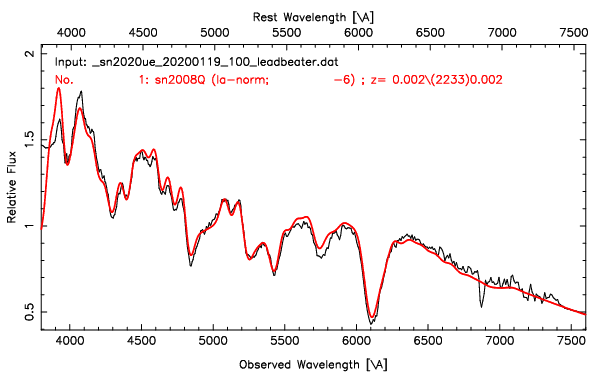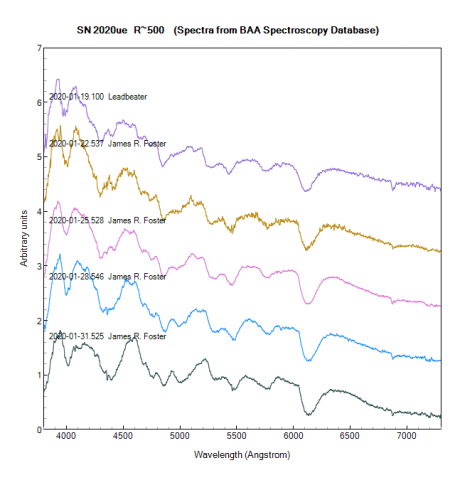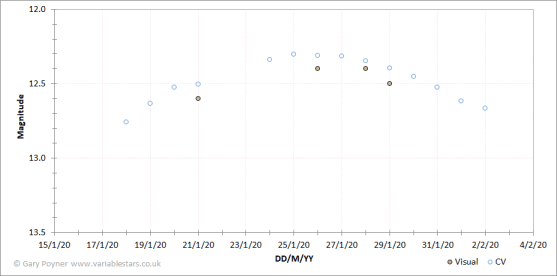- This topic has 9 replies, 4 voices, and was last updated 5 years, 10 months ago by
 Gary Poyner.
Gary Poyner.
-
AuthorPosts
-
13 January 2020 at 12:06 am #574496
 Robin LeadbeaterParticipant
Robin LeadbeaterParticipantWhile we wait for Betelgeuse to explode 😉 , there is another supernova which has the potential to be the brightest for some time
https://wis-tns.weiz…l/object/2020ue
Discovered today at mag 15 by Koichi Itagaki and confirmed as a type Ia, this could reach brighter than mag 12 depending on the extinction in the host galaxy. (SN 1939A, another type Ia in the same galaxy reached mag 11.9)
Cheers
Robin18 January 2020 at 12:14 pm #581917 Robin LeadbeaterParticipant
Robin LeadbeaterParticipantCurrently mag 12.8 as measured by Itagaki compared with his 14.9 discovery magnitude
18 January 2020 at 8:12 pm #581918 Gary PoynerParticipant
Gary PoynerParticipantI measured it at 12.759CV on Jan 18.138.
Neither the BAAVSS or AAVSO databases will accept the designation SN 2020ue yet, but hopefully this will be rectified before too long following a couple of e-mails sent today.
Gary
19 January 2020 at 1:24 pm #581921 Gary PoynerParticipant
Gary PoynerParticipantObservations of this SN can now be entered into the BAAVSS database as SN 2020ue or SN2020ue. Thanks Andy!
AAVSO still haven’t updated VSX though, so at this time you still can’t get the data into their database.
Brightened further to 12.632CV on Jan 19.222UT
Gary
19 January 2020 at 10:53 pm #581926 Robin LeadbeaterParticipant
Robin LeadbeaterParticipantFinally a clear night last night so was able to take a low noise spectrum at R~500 using the ALPY 600. Using SNID gives an exquisitely good detailed match to several Ia supernovae still a few days from maximum (black is my spectrum red is best match from SNID

Cheers
Robin
21 January 2020 at 9:54 am #581930 Andrew RobertsonParticipant
Andrew RobertsonParticipantHad a visual this morning at 1.30am in my 60 cm F4.5. I thought it’s brightness was roughly (very) somewhere between GSC 293-0572, mag 13.4 and HIP 62022, mag 11.3.
Andrew
21 January 2020 at 2:01 pm #581935 Gary PoynerParticipant
Gary PoynerParticipantThe AAVSO have now added this supernova to VSX, so you can now upload your observations to the AID. There is also a sequence available if you plot a chart using VSP http://www.aavso.org/vsp
May have reached maximum – 12.504CV on Jan 21.079 UT.
Gary
1 February 2020 at 2:32 pm #581993 Robin LeadbeaterParticipant
Robin LeadbeaterParticipantFrom the AAVSO light curve it looks like it reached maximum (~12.3 CV) on 25/26th Jan.
No chance to observe here for 2 weeks straight now (Even the odd clear spell has been bracketed by rain showers) but James Foster managed to get a few spectra and added them to our database.
 3 February 2020 at 7:03 pm #582007
3 February 2020 at 7:03 pm #582007 Tim HaymesParticipant
Tim HaymesParticipantI have measured it at 12.7 (unfiltered CCD) using the AAVSO chart (X25129DUM) and AstroArt 5. The telescope was the CHI-1 (Chile) on the Telescope Live network (Planewave CDK24, 60sec) – date 2020-02-03.360
4 February 2020 at 12:25 pm #582009 Gary PoynerParticipant
Gary PoynerParticipant
Slow decline has been ongoing since Jan 28, following a short flat maximum. Here is my plot up to and including Feb 02.073 UT
Gary
-
AuthorPosts
- You must be logged in to reply to this topic.
